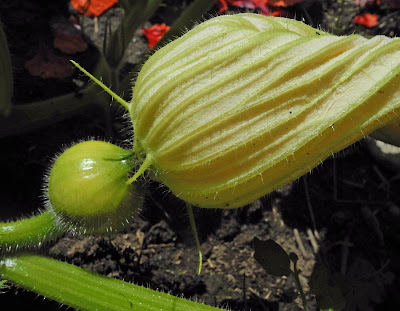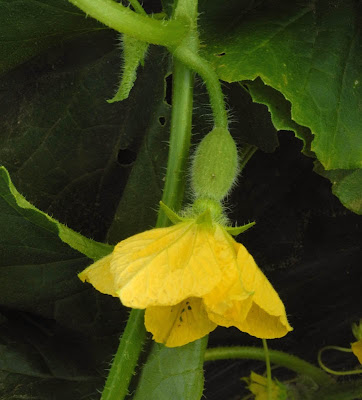 |
| Wild Blackberries |
We tend to think of flowers as delightful aesthetic objects, existing for our visual pleasure. It's true that many have been bred precisely for that: as objects of beauty; but of course, flowers are meant to do a job: they are the reproductive part of the plant, which will ensure its survival. When the sperm fertilizes the egg (yes, plants have them too), a seed will form. Those of us with flower borders go around deadheading the plants, cutting off the seeds that have grown from the flowers so as to save the plant's energy. When we are growing fruits or vegetables, however, those same seeds are within our crops. In the photo of a branch of wild blackberries, you can see the development from the flower (click to enlarge), how each tiny ovule is pollinated by a pollen grain, growing in a group to form a "berry". Raspberries would grow the same way, both pollinated by bees or other pollinators.
 |
| Peas |
Peas have pretty flowers, so much so that Sweet Peas were developed, a colorful, fragrant flower. But these are workaday flowers, self pollinating, creating the delicious peas that are just seeds for the next generation. I love seeing the tiny pods emerging from the flower, and watching how they grow and fill out.
 |
| Tomatoes |
Tomato flowers are also self pollinating, so don't need the busy bees to set fruit. The photograph shows different stages of tomato growth, from a drying flower having done its job, to a small fruit, to larger ones. It's curious to me that we call all these foods which contain seeds "vegetables", rather then fruit, which is what they actually are. I suppose it's because we think of "fruit" as a dessert.
 |
| Peppers |
Peppers, which are in the same family––the nightshades––as tomatoes and eggplants, grow in similar fashion: self pollinating flowers from which emerge the fruit.
 |
| Winter Squash |
The squash family goes about its seed producing business very differently: here there are separate male and female flowers, the female flower easily identifiable because of the small fruit at its base.
 |
| Melon |
In order for the fruit to be pollinated, flying pollinators are needed, and it's always a joy to see bees or other little insects moving in and out of the flowers. Without proper pollination, the fruit will just wither away instead of growing. I've never had luck trying to hand pollinate these plants, so rely on my insect friends. After many years of gardening, I still find it miraculous that a large plant will grow from a small seed and in turn create more seeds; it's the magic of life.
No comments:
Post a Comment